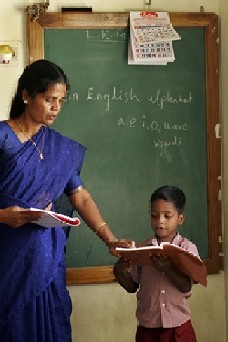We spent our last day in north India touring old Delhi (neighboring New Delhi is the modern seat of India’s government). This ancient city is fascinating for the sense of time and history and the many peoples and events that shaped India through the centuries. We especially enjoyed the old markets as we toured them in pedal rickshaws. Cars cannot fit in the narrow streets and alleys so the little rickshaws are the only option to walking. Our driver (peddler?) had enough English to provide some basic insight into the history. Terrorists bombed five markets the week before our visit but we saw no evidence and we didn’t feel threatened in the hustle and bustle of the busy day. I guess we wouldn’t think about it unless something actually happened.
The rickshaws are not really made for tall people but we got by just fine. We chose one with a cover because it looked like it would rain. Our driver asked me, “You have marriage?” I said, “Yes.” He asked, “How many wives?” (Vickie interjected, “What?!”) I replied, “One.” Said he, “Only one?” “Yes, only one.” Interesting question.
Here we are with the Karl and Amy Kirby family on a rooftop above the markets that also looked down on the courtyard of a mosque. From the left are Emily Bush, Gabriel Bush, Amy Bush Kirby with Gideon, Zakia Kirby, Karl, part of Kaleolani, and two unidentified tourists. Karl is serving as Rising Star’s resident doctor and medical outreach director for the year and we really enjoy their young family. Emily left for America on September 25 after two months of excellent volunteer service, and Gabe will be with us for the next few months. Volunteers do everything from handling building projects in the colonies and assisting the mobile medical crew to teaching English and running after-school programs for the kiddles.

Our guide knew enough people to get us access to the rooftops in the market area. This photo shows worshippers completing their ritual washing at the mosque before praying. It was interesting to hear the call for Muslim prayer broadcast from the tall minarets during the day. India is about 81% Hindu, 13% Muslim, 2% Sikh, 2% Christian, and 2% other, including Jain and Parsi.

Another option for travel in north India. Most of the camels we saw were pulling heavy loads, but we did see a couple of places advertising rides. Funny looking critters, aren’t they? But they have certainly fulfilled important roles in desert lands and Asian cultures. The script on the sign is Hindi, India’s official language and the tongue of about 60% of the citizens. Very different from the Tamil cursive with its 247 letters (we have enough trouble with 26). English is considered the associate official language in this nation that speaks dozens.

Vickie looking down on the inner courts of the spice market. The shops and buildings look much as they did at the founding of the British East India Company in the 18th century, and they don’t appear to have been cleaned since.

Here they are, folks; raw spices. Talk about launching a thousand ships—these little treasures were the whole reason behind the Age of Exploration and the battles for trade routes and rights through the centuries. The spice market was fascinating, but it nearly overwhelmed our tender olfactory senses.

And off we go through the narrow streets. The shops seem to specialize in one or two things. In the garment district we saw shelves stacked to the ceiling with bags of sequins or displaying one type of necklace. We really enjoyed our morning in a working market instead of visiting another bazaar meant mostly for tourists.










